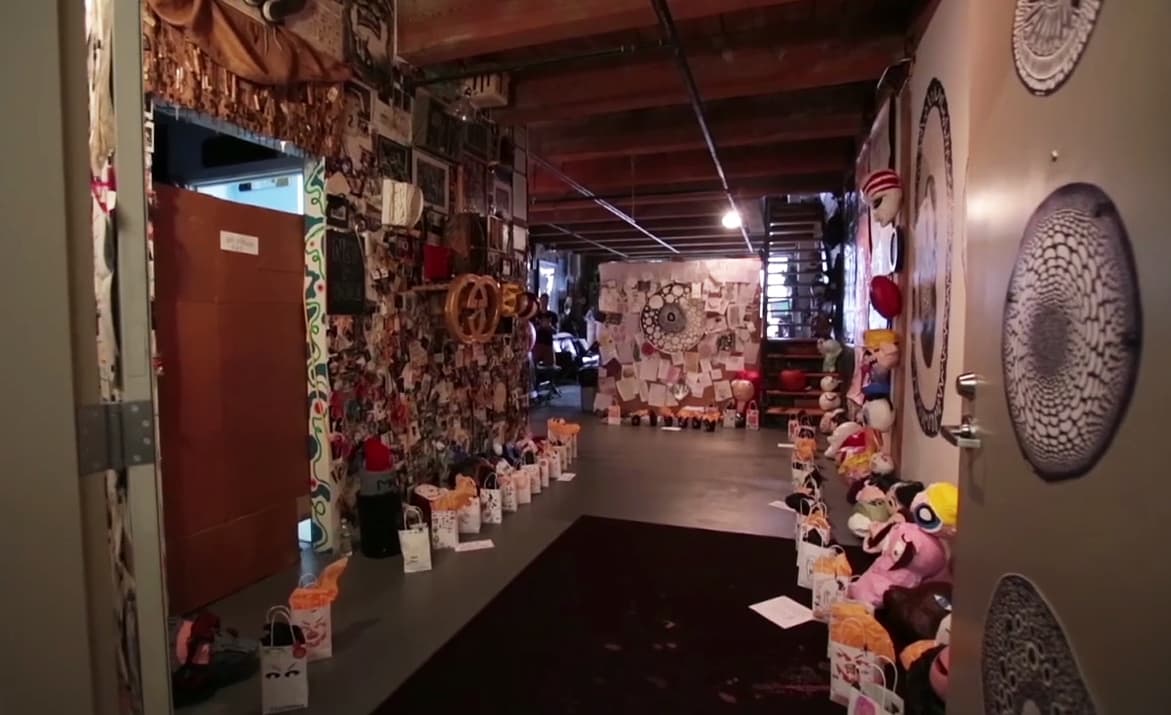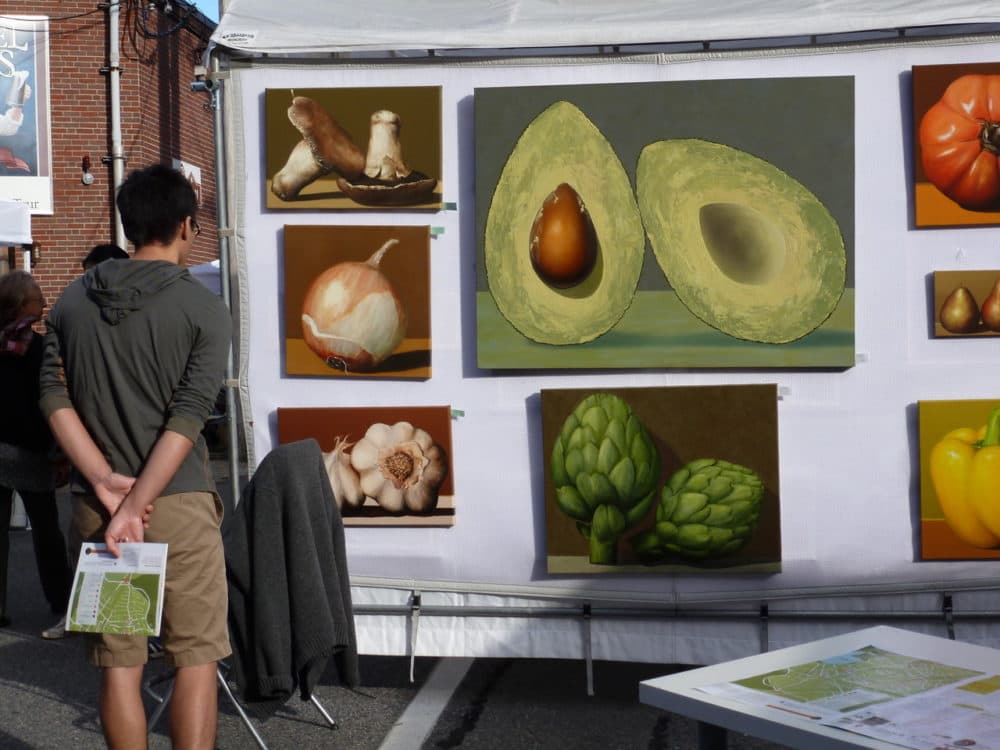Advertisement
Commentary
The Studios Are Open, But They're A Lot Emptier

Back in the early 2000s, I shared a large studio space in the South End with two other artists. The big event of the year was Fall Open Studios, when we and other artists in the neighborhood would throw open our doors to streams of curious visitors. The studio got so crowded at times that people could barely squeeze in.
Fast forward 10 years. The last time I did Open Studios was in 2014, and visitors trickled into my South End space with all the speed and vitality of ketchup plopping out of a bottle with a very tight neck. Maybe it was what I was showing (I didn’t think my work was that bad!) or maybe there was something else going on.
I started asking around.
“I’ve been doing South End since 2003,” my friend, former South End artist Fernando DeOliveira told me earlier this year. (He’s since moved to New Jersey and now has a studio in Chelsea, New York.) “Do you remember how it was then? There was a line outside the building to get into the studios! It was thousands of people to get in. When I did my first open studios, I sold $30,000 in one weekend. I used to sell $30-50,000 every other open studios.”
It’s not like that anymore.
I was talking with South End artist John Vinton on a completely different story, but took the opportunity to ask him, too.
“Gosh, we used to have hundreds and hundreds of people come,” he told me. “We had about 15 or 20 people come [in 2017]. There used to be quite a lot of people and quite a lot of interest. That’s just not true anymore at all.”
I checked with him again after the Open Studios in the South End last month and he again reported light turn out at his studio, although sales weren’t too bad.
This got me wondering: Are people getting burnt out on Open Studios?
“I don’t know what happened,” muses DeOliveira. “I think there are too many Open Studios… You have Jamaica Plain, Fort Point, Brickbottom. I think there are six to eight open studios… There are too many events.”
Actually, there are at least 13 Fall Open Studios events held in Boston neighborhoods, including Jamaica Plain, East Boston, Mattapan, Roxbury, Allston and South Boston, of which perhaps the South End and Fort Point have been historically the largest. They are held every weekend from mid-September through early December. This year, the season kicked off in the South End and concludes on Dec. 2 in Charlestown. The cycle starts up again in April and May when many neighborhoods, like Beacon Hill, the South End and Fort Point hold spring art walks alongside towns like Brookline and Somerville. This weekend, there will be Open Studios in both Fort Point and Allston.
Advertisement
Whether there is an actual drop in attendance, or just a change in which neighborhoods are seen as the “happening” havens for artistic creation is an open question. The Mayor’s Office of Arts and Culture could offer no data to settle the matter, although Kara Elliot-Ortega, Boston's chief of arts and culture, says the city recognizes the need to help bolster what was once a healthy annual rite around Boston. Her office has therefore created a new “Opportunity Fund” for Open Studios organizers which will grant money for marketing. This year, the city also created advertising for bus shelters and is “doing a better job generally of getting the word out.”
It could be that certain neighborhoods are seeing a decline in activity as they gentrify and become unaffordable to working artists. As the population of artists declines, so does foot traffic to Open Studios, since every artist attracts his or her own fan base who often end up poking a head into the studios of neighboring artists. The more artists showing, the bigger the “event” and the more patrons show up. When artist numbers dwindle, so do the patrons. Maybe that’s what happened in the South End. Neighborhoods that can hold onto artists may be seeing less of a decline. When I visited the Somerville Open Studios in May, the long halls of the Vernon Street Studios building were teeming with hip Somerville art aficionados bearing lattes and artist cards.
“My impression is that each open studio event is unique — each with their own strengths and challenges,” says Elliot-Ortega.
In the South End, Hope Ricciardi, chair of the United South End Artists, says that at one time, the SoWa building at 450 Harrison Ave. attracted as many as 10,000 visitors during an Open Studios weekend. Now, she reports those numbers are between 2,000 and 3,000. Sales are down too.
“Open Studios is not the event it used to be,” she says. “The slowest years were about 2010 to 2016. The last two years seem to be generating an increased crowd, but only to some locations.”

Ricciardi attributes slowed foot traffic to a decrease in artists working in the South End.
“This area had thousands of working artists at one time and now has about 200,” she says.
Buildings that do well, like 450 Harrison Ave., get strong support from such businesses as GTI Properties, which has long backed the arts in the neighborhood by printing flyers and marketing materials and providing logistical support to the SoWa arts events while renting studios to artists. The problem, according to Ricciardi, is that many patrons today only think of major institutions when they think of “supporting the arts.” They donate to arts organizations like the Museum of Fine Arts, the Boston Ballet or the Boston Symphony Orchestra, but they do not support artists themselves. Aside from GTI, corporations don’t seem to be giving either, in Ricciardi’s view.
“Our mission is to assist Boston artists who want to stay in the city, but it is becoming increasingly difficult,” she says. Especially since the South End was once the beating heart of creative enterprise in Boston, attracting not only many artists but most of the city's galleries.
"Many Boston area Open Studio events have disappeared and the few that continue need more financial support from City Hall and Boston businesses," Ricciardi says. "I can personally say that without the continued support from GTI Properties, I would not be able to continue and USEA would probably cease to exist (after 32 years of serving Boston artists).”
Until individual artists get access to more support, their survival may rely on their own marketing wiles. Emily O’Neill, interim executive director at Fort Point, says that in the final analysis, how much foot traffic flows through any one artist’s door may depend largely on the artist herself.
“I believe attendance depends on how well individual artists self-promote to their personal networks using social media,” she says. “Old school methods of posters, postcards and brochures are a bit dated.”
Ahh… and there it is. Perhaps that explains the drop off in attendance at my own Open Studio. It may finally be time to do that Facebook page I’ve been avoiding.
Fall Open Studios Calendar:
Fort Point Open Studios, Oct. 13 and 14, 12 to 6 p.m.
Allston Open Studios, Oct. 13 and 14, 12 to 6 p.m.
Roslindale Open Studios, Oct. 20 and 21, 11 a.m. to 5 p.m.
South Boston Open Studios, Nov. 3 and 4, 12 to 6 p.m.
Fenway Open Studios, Nov. 10 and 11, 11 a.m. to 5 p.m.
Charlestown Open Studios, Dec. 1 and 2, 11 a.m. to 5 p.m.
